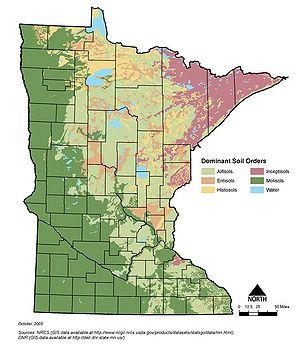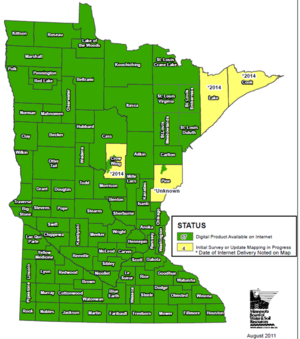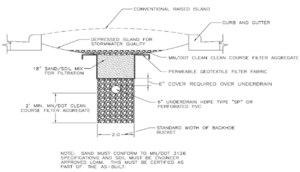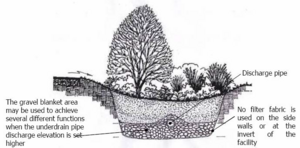
Difference between revisions of "Soils with low infiltration capacity"
m |
m |
||
| Line 3: | Line 3: | ||
[[File:Minnesota soil survey status.png|thumb|300px|alt=statewide map illustrating karst areas|<font size=3>Statewide map illustrating the availability of digital soil surveys. Cook, Koochiching, portions of Pine, and portions of Crow Wing counties are the only remaining areas in Minnesota lacking digital soil surveys. Source: [http://www.bwsr.state.mn.us/maps/Website/Technical%20Services/Soils%20Hydrology%20Vegetaion/Soils_Survey_Status.pdf]</font size>]] | [[File:Minnesota soil survey status.png|thumb|300px|alt=statewide map illustrating karst areas|<font size=3>Statewide map illustrating the availability of digital soil surveys. Cook, Koochiching, portions of Pine, and portions of Crow Wing counties are the only remaining areas in Minnesota lacking digital soil surveys. Source: [http://www.bwsr.state.mn.us/maps/Website/Technical%20Services/Soils%20Hydrology%20Vegetaion/Soils_Survey_Status.pdf]</font size>]] | ||
| − | Soils with low [[Glossary#I|infiltration]] capacity (defined as soils with infiltration rates less than 0.06 inches per hour) are found throughout the state. Details of where to find soils that can and cannot be used for infiltration systems should begin with available county soil surveys, most of which are available digitally. However, these surveys are not accurate enough to determine site specific characteristics suitable for infiltration systems, so a detailed site analysis is recommended. Stormwater management limitations in areas with tight soils generally preclude large-scale infiltration and ground water recharge (infiltration that passes into the ground water system). These soils will typically be categorized under [[Glossary#H|Hydrologic Soil Group]] (HSG) D. [[Design infiltration rates|Tabled values of infiltration rates]] for these soils are conservative estimates of long-term, sustainable infiltration rates that have been documented in Minnesota. They are based on in-situ measurement within existing infiltration practices in Minnesota, rather than national numbers or rates based on laboratory columns. The table below provides a general summary of infiltration rates for different soils. | + | Soils with low [[Glossary#I|infiltration]] capacity (defined as soils with infiltration rates less than 0.06 inches per hour) are found throughout the state. Details of where to find soils that can and cannot be used for infiltration systems should begin with available [http://www.nrcs.usda.gov/wps/portal/nrcs/surveylist/soils/survey/state/?stateId=MN county soil surveys], most of which are available digitally. However, these surveys are not accurate enough to determine site specific characteristics suitable for infiltration systems, so a detailed site analysis is recommended. (NOTE: If you know the name of a specific soil series, you can view detailed information about that soil at [https://soilseries.sc.egov.usda.gov/osdname.asp this site]. Stormwater management limitations in areas with tight soils generally preclude large-scale infiltration and ground water recharge (infiltration that passes into the ground water system). These soils will typically be categorized under [[Glossary#H|Hydrologic Soil Group]] (HSG) D. [[Design infiltration rates|Tabled values of infiltration rates]] for these soils are conservative estimates of long-term, sustainable infiltration rates that have been documented in Minnesota. They are based on in-situ measurement within existing infiltration practices in Minnesota, rather than national numbers or rates based on laboratory columns. The table below provides a general summary of infiltration rates for different soils. |
{{:Design infiltration rates}} | {{:Design infiltration rates}} | ||
Revision as of 18:55, 31 March 2015


Soils with low infiltration capacity (defined as soils with infiltration rates less than 0.06 inches per hour) are found throughout the state. Details of where to find soils that can and cannot be used for infiltration systems should begin with available county soil surveys, most of which are available digitally. However, these surveys are not accurate enough to determine site specific characteristics suitable for infiltration systems, so a detailed site analysis is recommended. (NOTE: If you know the name of a specific soil series, you can view detailed information about that soil at this site. Stormwater management limitations in areas with tight soils generally preclude large-scale infiltration and ground water recharge (infiltration that passes into the ground water system). These soils will typically be categorized under Hydrologic Soil Group (HSG) D. Tabled values of infiltration rates for these soils are conservative estimates of long-term, sustainable infiltration rates that have been documented in Minnesota. They are based on in-situ measurement within existing infiltration practices in Minnesota, rather than national numbers or rates based on laboratory columns. The table below provides a general summary of infiltration rates for different soils.
Design infiltration rates, in inches per hour, for A, B, C, and D soil groups. Corresponding USDA soil classification and Unified soil Classifications are included. Note that A and B soils have two infiltration rates that are a function of soil texture.*
The values shown in this table are for uncompacted soils. This table can be used as a guide to determine if a soil is compacted. For information on alleviating compacted soils, link here. If a soil is compacted, reduce the soil infiltration rate by one level (e.g. for a compacted B(SM) use the infiltration rate for a B(MH) soil).
Link to this table
| Hydrologic soil group | Infiltration rate (inches/hour) | Infiltration rate (centimeters/hour) | Soil textures | Corresponding Unified Soil ClassificationSuperscript text |
|---|---|---|---|---|
| Although a value of 1.63 inches per hour (4.14 centimeters per hour) may be used, it is Highly recommended that you conduct field infiltration tests or amend soils.b See Guidance for amending soils with rapid or high infiltration rates and Determining soil infiltration rates. |
gravel |
GW - Well-graded gravels, fine to coarse gravel GP - Poorly graded gravel |
||
| 1.63a | 4.14 |
silty gravels |
GM - Silty gravel |
|
| 0.8 | 2.03 |
sand |
SP - Poorly graded sand |
|
| 0.45 | 1.14 | silty sands | SM - Silty sand | |
| 0.3 | 0.76 | loam, silt loam | MH - Elastic silt | |
| 0.2 | 0.51 | Sandy clay loam, silts | ML - Silt | |
| 0.06 | 0.15 |
clay loam |
GC - Clayey gravel |
|
1For Unified Soil Classification, we show the basic text for each soil type. For more detailed descriptions, see the following links: The Unified Soil Classification System, CALIFORNIA DEPARTMENT OF TRANSPORTATION (CALTRANS) UNIFIED SOIL CLASSIFICATION SYSTEM
- NOTE that this table has been updated from Version 2.X of the Minnesota Stormwater Manual. The higher infiltration rate for B soils was decreased from 0.6 inches per hour to 0.45 inches per hour and a value of 0.06 is used for D soils (instead of < 0.2 in/hr).
Source: Thirty guidance manuals and many other stormwater references were reviewed to compile recommended infiltration rates. All of these sources use the following studies as the basis for their recommended infiltration rates: (1) Rawls, Brakensiek and Saxton (1982); (2) Rawls, Gimenez and Grossman (1998); (3) Bouwer and Rice (1984); and (4) Urban Hydrology for Small Watersheds (NRCS). SWWD, 2005, provides field documented data that supports the proposed infiltration rates. (view reference list)
aThis rate is consistent with the infiltration rate provided for the lower end of the Hydrologic Soil Group A soils in the Stormwater post-construction technical standards, Wisconsin Department of Natural Resources Conservation Practice Standards.
bThe infiltration rates in this table are recommended values for sizing stormwater practices based on information collected from soil borings or pits. A group of technical experts developed the table for the original Minnesota Stormwater Manual in 2005. Additional technical review resulted in an update to the table in 2011. Over the past 5 to 7 years, several government agencies revised or developed guidance for designing infiltration practices. Several states now require or strongly recommend field infiltration tests. Examples include North Carolina, New York, Georgia, and the City of Philadelphia. The states of Washington and Maine strongly recommend field testing for infiltration rates, but both states allow grain size analyses in the determination of infiltration rates. The Minnesota Stormwater Manual strongly recommends field testing for infiltration rate, but allows information from soil borings or pits to be used in determining infiltration rate. A literature review suggests the values in the design infiltration rate table are not appropriate for soils with very high infiltration rates. This includes gravels, sandy gravels, and uniformly graded sands. Infiltration rates for these geologic materials are higher than indicated in the table.
References: Clapp, R. B., and George M. Hornberger. 1978. Empirical equations for some soil hydraulic properties. Water Resources Research. 14:4:601–604; Moynihan, K., and Vasconcelos, J. 2014. SWMM Modeling of a Rural Watershed in the Lower Coastal Plains of the United States. Journal of Water Management Modeling. C372; Rawls, W.J., D. Gimenez, and R. Grossman. 1998. Use of soil texture, bulk density and slope of the water retention curve to predict saturated hydraulic conductivity Transactions of the ASAE. VOL. 41(4): 983-988; Saxton, K.E., and W. J. Rawls. 2005. Soil Water Characteristic Estimates by Texture and Organic Matter for Hydrologic Solutions. Soil Science Society of America Journal. 70:5:1569-1578.
Contents
Stormwater concerns on soils with low infiltration capacity
Sites with poorly infiltrating soils (defined as soils with infiltration rates less than 0.06 inches per hour) limit the number of practices that can used for stormwater management on a site or specific area of a site. Certain watershed organizations in Minnesota do not allow the use (or strongly discourage the use) of infiltration practices where soil infiltration capacity is low. This does not mean, however, that these tight soils don’t have any infiltration and recharge capabilities. So it may be possible for sites to meet recharge objectives as long as appropriate design modifications have been incorporated.
General stormwater management guidelines for sites with low infiltration capacity soils
- Local soil surveys should be used for preliminary determination of infiltration capacity of site soils; however, on-site soil testing is recommended to accurately characterize site soils if local surveys characterize site soils as either HSG C or D.
- Recharge criteria, if applicable, can still be met using infiltration practices or modified filter designs, such as the modified sand filter design or the bioretention system with infiltration gallery shown on the right. As with any BMP, these must be appropriately designed.
- Soil compost amendments may be required to increase pervious area storage and filtration rates for sites with HSG C and D soils that are expected to receive either rooftop or surface IC disconnection in accordance with certain stormwater credits.
- Where volume reduction is a primary objective for a site (e.g., potentially a receiving water-based goal due to channel erosion, nuisance flooding, or inadequate infrastructure capacity), emphasis should be placed on practices that promote runoff reuse and evapotranspiration such as cisterns, rain barrels, green roofs, rain gardens, evaporative systems, and bioretention.
The following table provides an overview of low infiltration capacity soil related design considerations for several structural practice groups.
This table shows structural BMP use in soil with low infiltration capacity
Link to this table
| BMP | Low infiltration capacity soil considerations |
|---|---|
| Bioretention, dry swale, permeable pavement, tree trench/box | Should be constructed with an underdrain. Recharge criteria, if applicable, can be met by modifying the design to include an infiltration gallery below the underdrain, so long as it is appropriately sized. |
| Media filter | Recommended practice in tight soils. Some design variants can be modified to incorporate an infiltration gallery that can help meet recharge criteria, if properly sized. |
| Infiltration trench or basin |
|
| Stormwater ponds | Acceptable practice with tight soils. Soils should help maintain permanent pool. |
| Constructed wetlands |
|
Investigation for low infiltration capacity soils
Soil testing is recommended for all proposed stormwater facilities that plan to have a recharge or infiltration component to their design. Testing can be less rigorous than that for karst areas or sites with shallow bedrock and soils. The purpose of the testing is to identify and confirm the soil characteristics and determine their suitability, if any, for infiltration practices. The guidelines outlined below should not be interpreted as all-inclusive. The design of any subsurface investigation should reflect the size and complexity of the proposed project.
Location of borings
Borings should be located in order to provide representative area coverage of the of the proposed BMP facilities. The location of borings should be
- in each geologic unit present, as mapped by the Minnesota Geological Survey (MGS) and U.S. Geological Survey (USGS) and local county records;
- near the edges and center of the proposed practice and spaced at equal distances from one another; and
- near any areas identified as anomalies from any existing geophysical studies.
Number of borings
The number of recommended borings are described below.
- Infiltration trenches, bioretention, and filters - a minimum of 2 per practice.
- Ponds/wetlands - a minimum of 3 per practice, or 3 per acre, whichever is greater.
- Additional borings - to define lateral extent of limiting horizons, or site specific conditions, where applicable.
Depth of borings
Borings should be extended to a minimum depth of 5 feet below the lowest proposed grade within the practice unless auger/backhoe refusal is encountered.
Identification of material
All material penetrated by the boring should be identified, as follows:
- description, logging, and sampling for the entire depth of the boring;
- any stains, odors, or other indications of environmental degradation;
- a minimum laboratory analysis of 2 soil samples, representative of the material penetrated including potential limiting horizons, with the results compared to the field descriptions;
- identified characteristics should include, as a minimum: color; mineral composition; grain size, shape, and sorting; and saturation;
- any indications of water saturation should be carefully logged, to include both perched and groundwater table levels, and descriptions of soils that are mottled or gleyed should be provided; and
- water levels in all borings should be taken at the time of completion and again 24 hours after completion. The boring should remain fully open to total depth of these measurements.
Infiltration rate testing
Soil permeabilities should be determined in the field using the following procedure (MDE, 2000), or an accepted alternative method.
- Install casing (solid 6-inch diameter) to 36 inches below proposed practice bottom.
- Remove any smeared soiled surfaces and provide a natural soil interface into which water may percolate. Remove all loose material from the casing. Upon the tester’s discretion, a 2-inch layer of coarse sand or fine gravel may be placed to protect the bottom from scouring. Fill casing with clean water to a depth of 36 inches and allow to pre-soak for up to 24 hours.
- Refill casing with another 36 inches of clean water and monitor water level (measured drop from the top of the casing) for 1 hour. Repeat this procedure (filling the casing each time) three additional times, for a total of 4 observations. Upon the tester’s discretion, the final field rate may either be the average of the 4 observations, or the value of the last observation. The final rate should be reported in inches per hour.
- May be done through a boring or open excavation.
- The location of the test should correspond to the practice location.
- Upon completion of the testing, the casings should be immediately pulled, and the test pit should be back-filled.

